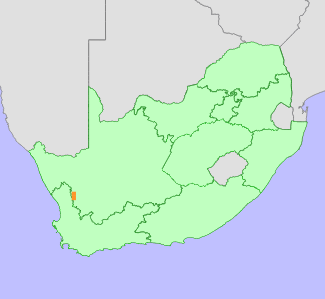|
Scientific Name | Sparaxis tricolor (Schneev.) Ker Gawl. |
Higher Classification | Monocotyledons |
Family | IRIDACEAE |
Synonyms | Ixia tricolor Schneev., Sparaxis blanda Sweet, Sparaxis grandiflora (D.Delaroche) Ker Gawl. var. lineata (Sweet) Baker, Sparaxis griffinii Sweet, Sparaxis lineata Sweet, Sparaxis tricolor (Schneev.) Ker Gawl. var. blanda (Sweet) Baker, Sparaxis tricolor (Schneev.) Ker Gawl. var. griffinii (Sweet) Baker, Sparaxis versicolor Sweet, Streptanthera lineata (Sweet) Klatt, Streptanthera tricolor (Schneev.) Klatt |
Common Names | Fluweelblom (a), Fluweeltjie (a), Harlequin Satinflower (e), Orange Satinflower (e) |
National Status |
Status and Criteria | Vulnerable B1ab(ii,iii,v)+2ab(ii,iii,v) |
Assessment Date | 2021/09/17 |
Assessor(s) | P. Goldblatt, D. Raimondo, J.C. Manning, L. von Staden & T. Patel |
Justification | This is a highly localized species, with an extent of occurrence (EOO) and an area of occupancy (AOO) of 44 km². It is locally abundant. However, an estimated seven extant locations continue to decline due to ongoing habitat loss and degradation, as well as competition from alien invasive plants. It is therefore listed as Vulnerable under criteria B. |
Distribution |
Endemism | South African endemic |
Provincial distribution | Northern Cape |
Range | It is endemic to South Africa, and is found on the Bokkeveld Plateau around Nieuwoudtville in Northern Cape. |
Habitat and Ecology |
Major system | Terrestrial |
Major habitats | Nieuwoudtville Shale Renosterveld, Bokkeveld Sandstone Fynbos |
Description | It occurs in seasonally wet places and watercourses in tillite-sandstone transition soils, often wedged among rocks. |
Threats |
| At least 61% of its renosterveld habitat has been converted to crop fields, especially north of Nieuwoudtville, where only small remnants remain (calculated using landcover data in GIS). It occurs on clay flats where it is vulnerable to ongoing agricultural expansion, but plants also often occur in rocky outcrops unsuitable to ploughing. Competition from alien invasive grasses is also an ongoing threat across most of this species' very narrow range (Goldblatt and Manning 2013). |
Population |
Two subpopulations are known, the first, consisting of several thousand individuals, occurs across three adjacent farms to the north of Nieuwoudtville. The second is much smaller, consisting of around 100 mature individuals (D. Raimondo pers. obs.). The population has an overall decreasing trend.
|
Population trend | Decreasing |
Assessment History |
Taxon assessed |
Status and Criteria |
Citation/Red List version | | Sparaxis tricolor (Schneev.) Ker Gawl. | VU D2 | Raimondo et al. (2009) | | Sparaxis tricolor (Schneev.) Ker Gawl. | Vulnerable | Hilton-Taylor (1996) | | Sparaxis tricolor (Schneev.) Ker Gawl. | Endangered | Hall et al. (1980) | |
Bibliography |
Goldblatt, P. and Manning, J.C. 2000. Cape Plants: A conspectus of the Cape Flora of South Africa. Strelitzia 9. National Botanical Institute, Cape Town.
Goldblatt, P. and Manning, J.C. 2013. Systematics and biology of the Cape genus Sparaxis (Iridaceae). Strelitzia 32. South African National Biodiversity Institute, Pretoria.
Hall, A.V., De Winter, M., De Winter, B. and Van Oosterhout, S.A.M. 1980. Threatened plants of southern Africa. South African National Scienctific Programmes Report 45. CSIR, Pretoria.
Hilton-Taylor, C. 1996. Red data list of southern African plants. Strelitzia 4. South African National Botanical Institute, Pretoria.
Raimondo, D., von Staden, L., Foden, W., Victor, J.E., Helme, N.A., Turner, R.C., Kamundi, D.A. and Manyama, P.A. 2009. Red List of South African Plants. Strelitzia 25. South African National Biodiversity Institute, Pretoria.
|
Citation |
| Goldblatt, P., Raimondo, D., Manning, J.C., von Staden, L. & Patel, T. 2021. Sparaxis tricolor (Schneev.) Ker Gawl. National Assessment: Red List of South African Plants version 2024.1. Accessed on 2025/12/09 |
 Comment on this assessment
Comment on this assessment

